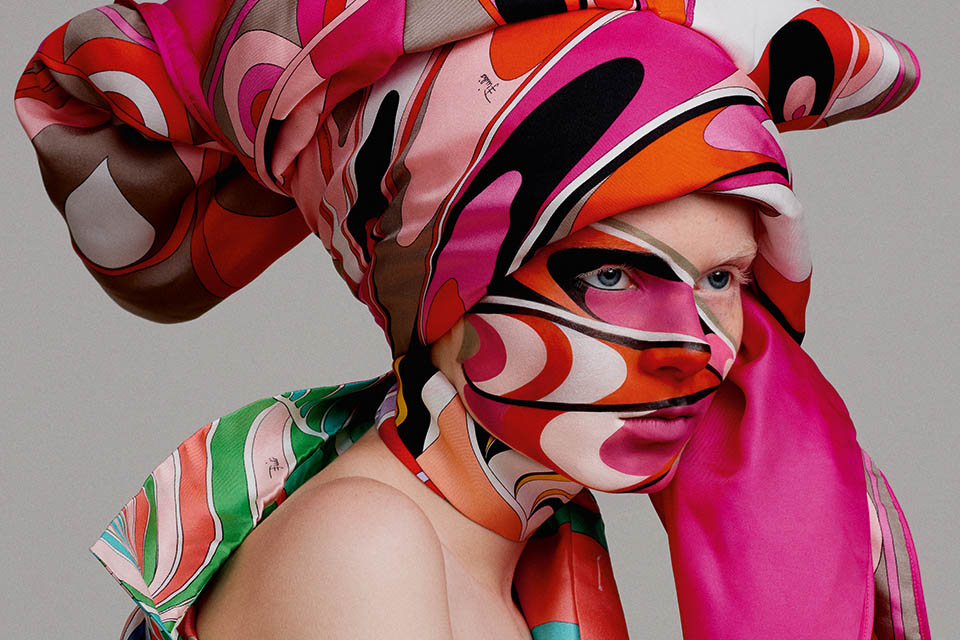His prints are as refreshing as Campari soda on ice and his clothes are pure vacation feeling. TASCHEN dedicates a work to Emilio Pucci that weighs at least as much as his legacy, and includes sketches and photographs from the period in which Pucci first enchanted Capri’s jet set and then the entire fashion world.
A bird of paradise surrounded by ravens. This is how you could describe Emilio Pucci. While he threw color around like believers at the Indian Holi festival, Prada, Gucci and Co. kept a low profile. The world was Pucci’s inkbox and its colors his DNA. For a long time, it did not look as if the scion of aristocratic ancestors would even join the fashion clique. Pucci studied in Milan, Florence and the USA. Dad wanted it that way, and Count Pucci was not contradicted. However, the Naples-born Italian not only did well behind the school desk, but also on skis. In 1934, he joined the Italian Olympic ski team, raced against other nations and won scholarships thanks to his sporting successes in order to quench his own thirst for knowledge and his father’s thirst for success. Emilio Pucci was annoyed by the boring suits he and his team had to wear as they hurtled down the slope on waxed boards. In short, he took the design of the uniforms into his own hands and set the course for his future work. But it was a while before Pucci found his calling. The world turned gray with the Second World War. The 25-year-old Pucci found himself in the middle of a battle as the captain of a torpedo bomber and once again made his family proud with his efforts. Two years after Europe had calmed down again, Emilio Pucci continued the thread and designed a ski outfit that Harper’s Bazaar magazine celebrated like the new designs of the then fashion favorite Christian Dior. What Pucci designed was different. More colorful, brimming with joie de vivre, it sold better than lemon sorbet on a hot summer’s day. He opened his first boutique on Capri, but chose not to use his famous surname. What hung in Emilio’s shop window was soon worn not only by the ladies of the Italian jet set, but also by Sophia Loren, Grace Kelly and Marilyn Monroe. The breezy dresses, blouses and capri pants looked good on the Italian Riviera and exuded a vacation feeling even where the hectic pace of everyday life crammed the lust for life back into the briefcase. Because what Emilio Pucci mastered like no other: the creation of prints and colors. By the time of his death in 1992, Pucci had added around 510 shades of color to his palette. While his company grew like the crowds of tourists on Capri, Pucci helped the flight attendants of Braniff International Airways to get new uniforms in the 1960s and later even designed the logo for NASA’s Apollo 15 mission. In 1985, his daughter Marchesa Laudomia joined him at the creative table, who later not only managed the company but also sold 70 percent of it to the luxury group LVMH in 2000. In 2002, the latter hired Frenchman Christian Lacroix as head designer, whose position was taken over by Englishman Matthew Williamson from 2005 to 2008. The Norwegian designer Peter Dundas has been at the helm of the label since October 2008 and is trying to create collections that do justice to the bird of paradise of fashion, following Pucci’s example.
Pucci. Updated Edition
The homage that TASCHEN Verlag is paying to Emilio Pucci with the book named after him weighs around five and a half kilograms. It features the prints that earned the Italian designer the admiration of the fashion industry and made Sophia Loren and Marilyn Monroe his fans. Sketches and photographs are placed side by side and tell the story of a man whose fashion career began with skiwear. Various original Pucci patterns adorn the cover of each volume, which comes dressed in fabric patterns. An object of desire for every Pucci fan and number one on the must-have list of all those who love coffee-table books as much as Emilio Pucci loves his prints. Vanessa Friedman, Alessandra Arezzi Boza, Armando Chitolina, “Pucci. Updated Edition”, hardcover, 5.45 kg, 448 pages, TASCHEN Verlag, approx. 200.-(www.taschen.com)

























